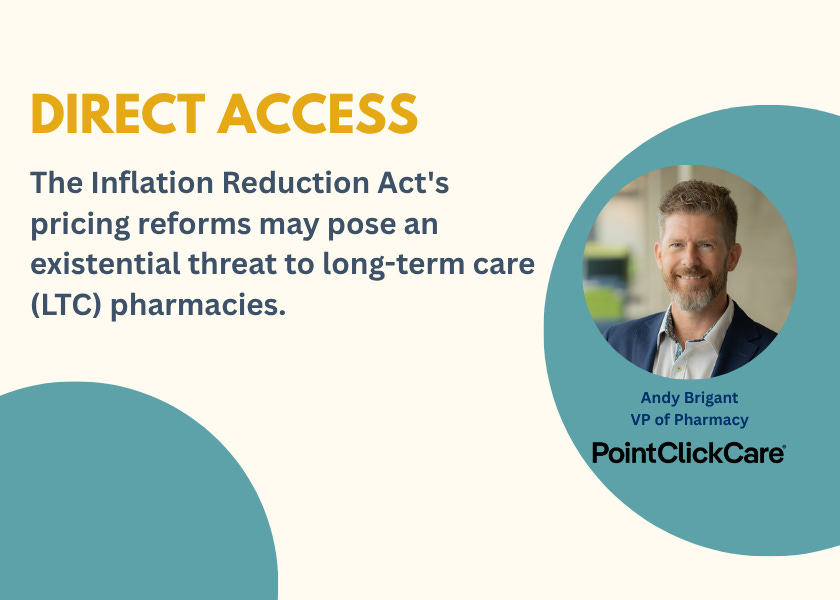The Policy Shockwave: How the IRA Is Reshaping Long-Term Care Pharmacy
The Inflation Reduction Act's pricing reforms may pose an existential threat to long-term care (LTC) pharmacies.
The Inflation Reduction Act (IRA) was passed with the intention to lower drug costs via the Medicare Drug Price Negotiation Program. However, in practice, it has come to present what may be an existential threat to long-term care (LTC) pharmacies by potentially reducing already thin margins.
In this Direct Access interview, Pharmacy Technology & Management Review Senior Editor Will Lockwood talks with PointClickCare VP of Pharmacy, Andy Brigant, about the IRA.
Brigant explains the details of the Maximum Fair Prices (MFPs) that will target 16 of the top 50 drugs LTC pharmacies dispense, and why this could slash operating margins by at least one-third. Because LTC pharmacies offer specialized services — like 24/7 support and custom packaging — that are not separately reimbursed, this financial squeeze forces them to consider drastic cuts.
PTMR: For those not as familiar, what do the IRA Drug Price Negotiations mean for LTC pharmacies, and why is this such a pivotal issue?
Andy Brigant: IRA drug price negotiations, or the Medicare Drug Price Negotiation Program, was initiated by the Biden administration to address rising medication costs that have significantly increased overall healthcare spending in the United States. The approach taken was to establish price caps — MFPs — for some of the brand medications that drive a large portion of the Medicare Part D, and eventually Medicare Part B, spend. A key premise of this approach is that pharmaceutical manufacturers are building unfair margins into their prices while operating under patent protection.
Medications on the targeted list will be added in waves, with 10 Part D medications initially being capped starting January 2026, and an additional 15 Part D medications being added in January 2027. After 2028, Part B drugs, such as injections and infusions, typically administered by professionals, will become eligible. It’s expected that 15 or more drugs may be added to the program in each successive year. The medications that have already been identified constitute 16 of the top 50 drugs dispensed by LTC pharmacies.
The implementation of this program is complex, and involves adjustments to payments between many players, including manufacturers, wholesalers, pharmacy benefit managers (PBMs), plans, and pharmacy operators.
An unintended consequence of all this is that LTC pharmacies may be critically impacted. Unlike some of the other players mentioned above, LTC pharmacies operate on very tight margins. Compared to their retail pharmacy counterparts, LTC pharmacies do not have a diversified revenue mix, like consumer goods, and can only generate margin off of the difference between the cost they pay for the medication, and their reimbursement from drug plans, dispense fees, and manufacturer rebates. Through studies ordered by the Senior Care Pharmacy Coalition (SCPC), it’s estimated that the typical pharmacy will lose at least one-third of their overall operating margin, with some being impacted more seriously. It’s worth noting that these price caps are in addition to insulin price caps that have been established over the last couple of years.
PTMR: With the IRA reducing reimbursement margins on key Medicare Part D drugs and LTC pharmacies at risk of losing financial stability, how do you see pharmacies adapting their business models to navigate these pressures while continuing to deliver high-quality medication management services for residents?
Brigant: Some pharmacies are already preparing for the worst-case scenario, and there are some common themes. Pharmacies are standardizing their operations as much as possible. While today for example, they may accommodate more flexible delivery schedules, they may look to optimize and reduce their routes, which could negatively impact timely availability of some medications. Services that were once offered at no charge, like vaccine clinics, may be cut back or come with new added fees.
Proactive pharmacies are looking through every part of their business to see where time and resources are being spent and evaluating what can be cut. But there are limits to how much can be cut without affecting care or compliance. Without policy changes, some pharmacies won’t be able to adapt. We may see closures or consolidation as smaller players are acquired by larger operators, or just driven out of business.
PTMR: It sounds like a lot of changes are about to take effect across the industry. What is the likely impact of these changes on the senior care sector? And should people be concerned?
Brigant: The impact on the sector and senior care in general could be significant. LTC pharmacies exist to provide specialized geriatric care services for seniors, and operate in a way that is heavily aligned with how medications are managed in congregate care settings. From specialized order management and delivery arrangements, to packaging solutions, in-services, consultant reviews and integration support, LTC pharmacies have evolved to be indispensable partners to SNF and ALF operators. Some smaller, less well financed pharmacies servicing rural and specialty populations won’t be easy to replace.
At the end of the day, optimizing operations further will only go so far, and service levels to SNFs and ALFs, and the vulnerable populations that they serve, are likely to be impacted. The small amount that may be saved by not accommodating the unique needs of senior care settings may be dwarfed by the cost of poor clinical outcomes that could be the result of a disruption in pharmacy services.
PTMR: Do you see any avenues for impacting the situation in a positive way for the senior care sector?
Brigant: Industry groups like the American Society of Consultant Pharmacies (ASCP) and Senior Care Pharmacy Coalition (SCPC) are working hard with congress and the administration to find some solutions. The one that looks like it has the best chance to impact the situation prior to January 2026 is H.R. 5031, the Preserving Patient Access to Long-Term Care Pharmacies Act. The proposed legislation has been introduced to the House in August 2025 with sponsors from both parties. It proposes a $30 dispense fee allowance to the pharmacy for any prescription impacted by MFP. That amount is based on studies of the true cost to dispense, covering specialized packaging, delivery, emergency supply, and regulatory compliance requirements like pharmacy consulting services.
With everything going on in Congress today, time is extremely tight. We’re encouraging everybody concerned with the health of the senior care sector to reach out to their federal representatives and express support for H.R. 5031
PTMR: Looking ahead, what does the future hold for pharmacy?
Brigant: As a technologist, I’m optimistic by nature. This is an industry full of dedicated professionals and innovative companies. There are still efficiencies to be found, and new technologies on the horizon, including AI, offer opportunities to improve outcomes and streamline operations.
However, with the shifting demographics and increasing pressure on senior healthcare resources, we’ll need all those technological advances to serve the needs of the aging population as it is. If the money stops flowing to keep companies solvent, we will see a lot of disruption, and we will see pharmacies closing. Not all of the coverage for the affected residents will be absorbed by other pharmacies, and I fear for the impact on resident health outcomes. PTMR
Andy Brigant is a seasoned healthcare and technology professional, serving as the Vice President of Pharmacy at PointClickCare. With over twenty-five years of experience in the industry, Andy has been an integral part of the PointClickCare team since 2000. During his tenure, he has played a leading role in the design and architecture of the PointClickCare system, and growing PointClickCare’s connection to long-term care pharmacy.
Throughout his career, Andy has held various leadership positions in engineering, product development, operations, and sales. His expertise and dedication have allowed him to focus specifically on shaping pharmacy strategy for over 10 years. In his current role as Vice President Pharmacy, Andy is instrumental in enhancing PointClickCare’s medication management capabilities and fostering strong relationships within the pharmacy partner community.
Sponsored



